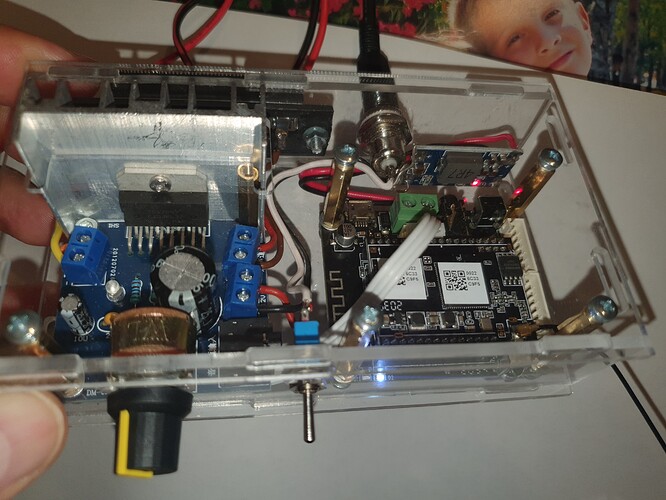Thanks Kevin & Simon for your response! Thanks for hanging in to help me solve this issue. For me this is a ‘don’t give up’ case.
I will respond to both if you in one message. And I will additionally share some tests I did and their outcome.
Noise: let me say something about this, as the definition of noise is sometimes explained differently. The noise I am experiencing is not constant; it varies a bit like a high-pitched whistle. I believe some people call it hiss.
The BeoLab 8000 active speaker (See this link) has 3 speakers and a bass reflex pipe. The bottom and middle speakers are physically the same, but the bottom is driven as a woofer and the middle one as mid-tone driver.
The noise/hiss I have can mainly be heard from the mid-tone driver.
Test music: I mainly test if the noise/hiss is still there playing ‘Bob Dylan, Man in the long black coat’. In the starting seconds the music is low but present, and the noise/hiss can clearly be heard. Listening to this same recording via headphones, there is no noise/hiss. So I am sure the noise/hiss is not in the recording.
Q Kevin: Would you both say that the noise/hum is completely independent of which channel you are using? 1. is the noise spread nicely over both L/R channels? 2. Inversion left to right and vice versa has the same overall result?
Answer: yes, it is spread over both channels, and it is evenly on both. Inversion L to R and vice versa has the same result.
Schematics overall: See the picture below for a drawing of how my setup is connected for both power and for audio signal.
Power supply to Up2Stream Mini: As I have built everything inside the speaker casing of the BeoLab 8000, I am tapping 230 volts from where the power comes into the BeoLab. This goes directly to a separate 230v DC-to-5v AC power supply, which feeds the Up2Stream Mini. I have tested two of those power supplies (both 5v, 1A):
I have also tested powering the Up2Stream Mini with a battery pack. But in all three cases, it makes no difference, the noise/hiss is still there.
Up2Stream Mini signal test via headphones (Simon): As suggested I tested the audio-OUT signal from the Up2Stream Mini via headphones. In this test, the Up2Stream Mini was still power connected to the B&O power input and the ‘230v DC-to-5v AC’ power supply mentioned before. Playing the same Bob Dylan test music, there is NO noise/hiss on the headphones! So I assume the Up2Stream Mini is producing a clear signal, and maybe it can be excluded as problem source. Though in my setup I am not using the mini jack on the Up2Stream as audio out, but the 4-pin connector on the PCB. (Does that make a difference?)
Audio connection in my setup: Here’s some explanation how I have made the audio connection (See below picture as a reference). The internal Amp of the BeoLab 8000 has an audio-IN connector on the Amp PCB. The connector is named P4 and is a JST PH2.0 3-pin connector. Though the speaker is only used for Left or Right channel, there are 3 connections used, because the BeoLab uses an ‘Auto Stand-by’ switch that is listening to the audio signal coming in via the P4 connection. In practice it means that the 1st pin of this connector is used for listening; if audio comes in, the BeoLab amp is switched on (and switched off again when music ends). The 2nd pin is used for Left or Right audio-IN signal and the 3rd pin is the ground. So all three pins have to be used, otherwise the BeoLab ‘Auto Stand-by’ functionality will not work properly.
Audio cable: to connect the audio-OUT connector on the Up2Stream Mini PCB to the P4 audio-IN connector on the BeoLab 8000 Amp, I made a custom cable. I used the 4-pin connector cable that comes with the Up2Stream Mini, cut off the connector on one side, and also cut off wire nr. 4 (not used). And as shown in the above schematics, I soldered all the right connections together and shrink wrapped the soldering points.
Originally, my cable was about 30cm long and un-shielded. So, I thought maybe this cable is the ‘antenna’ picking up the disturbance and causing the noise/hiss. So, I replaced it by a shorter and shielded cable in the same connection-configuration: appr. 10cm, of which 8cm shielded. But also this change did not solve the noise/hiss.
Schematics BeoLab power unit and Amp:
For your reference, I have the BeoLab 8000 Service manual available. It includes the schematics for electronics. See this link.
Considerations:
I am not sure, but it came to my mind that certain capacitors might be a problem. After all, the BeoLab 8000 is still a fantastic active speaker, but also rather old. I have 2 units that are from the late 90’s and 2 units that are probably 10 to 15 years old. Though, I also noticed that the noise/hiss is the same on all 4 speakers.







